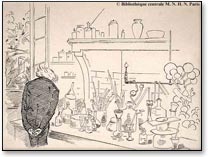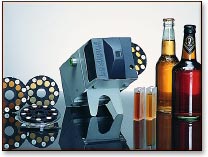Margarine was developed in 1869 by a French pharmacist and chemist, Hippolyte Mège-Mouriés, after Napoleon III offered a prize for the formulation of a synthetic edible fat. Western Europe was running low on fats and oils; petroleum hydrocarbons were as yet unexploited, and the growing industrial need for lubricants and the popular demand for soaps (caused by a rising standard of living and interest in hygiene) were cutting into vegetable sources.
The name margarine comes from a minor scientific error. Michel Chevreul, a chemist whose investigations of color influenced the painter Seurat, also worked on natural fats early in his career, isolating and naming many fatty acids and establishing a model of analytic research in the heretofore rather casual field of organic chemistry. Mège-Mouriés was looking for a butter substitute, and so of course had to use animal fats, which are semisolid at room temperature. Mège-Mouriés was not the first to give suet a buttery texture, but he was the first to make it palatable by flavoring it with a small amount of milk. It was not until 1905, after French and German chemists had developed the process of hydrogenation for hardening normally liquid vegetable oils, that these oils could be made into a butter substitute.
Margarine caught on quickly in both Europe and the United States, where patents began pouring out in 1871, and large-scale production was under way by 1880. At the turn of the century, Mark Twain overheard a conversation between two businessmen aboard the Cincinnati riverboat, and recorded it in Life on the Mississippi.
Why, we are turning out oleomargarine now, by the thousands of tons. And we can sell it so dirt-cheap that the whole country has got to take it-can't get around it, you see. Butter don't stand any show-there ain't any chance for competition.
Little did this enthusiast suspect what resistance margarine would meet from the dairy industry and from government. First it was defined as a "harmful drug" and its sale restricted. Then it was heavily taxed, stores had to be licensed to sell it, and, like alcohol and tobacco, it was bootlegged. The government refused to purchase it for use in the armed forces. And, in an attempt to hold it to its true colors, some states did not allow margarine to be dyed yellow (animal fats and vegetable oils are much paler than butter); the dye was sold separately and mixed in by the consumer. Two world wars, which brought butter rationing, probably did the most to establish margarine's respectability. But it was not until 1950 that the federal taxes on margarine were abolished, and not until 1967 that yellow margarine could be sold in Wisconsin.



